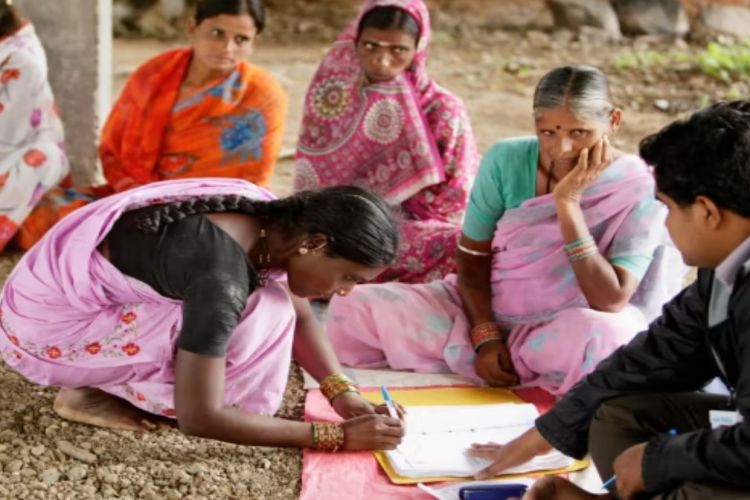
India’s microfinance sector, once hailed as a cornerstone of financial inclusion, is now under strain as lenders adopt a more cautious stance amid persistent credit stress. Disbursements shrank sharply in the fourth quarter of FY2024-25, plunging 38% year-on-year—a stark signal of risk aversion creeping into a sector built on outreach and access.
Yet, signs of a selective recovery are emerging. According to the latest MicroLend report by credit bureau CRIF High Mark, disbursements rose 12% sequentially in the March quarter to Rs 71,580 crore, driven by an uptick in high-ticket loans. This cautious optimism suggests lenders are favouring quality over volume, even as overall sentiment remains subdued.
READ | Northeast India’s economic revival hinges on social harmony
The industry’s gross loan portfolio (GLP) contracted significantly, falling 13.9% to Rs 3.81 lakh crore as of March 2025 from Rs 4.43 lakh crore a year earlier. This decline reflects lenders’ efforts to rein in exposure and manage portfolio risks amid tightening regulations and evolving repayment practices.
Loan defaults on the rise
The most alarming trend, however, is the steep rise in delinquencies. Loans overdue by more than 31 days—classified as Portfolio at Risk (PAR)—soared by 163% year-on-year to Rs 43,075 crore. The 31–180 day overdue bucket now accounts for 6.2% of the portfolio, up from 2.1% a year ago. Loans overdue by more than 180 days have similarly surged to 5.1%, from 1.6% the previous year. These figures reveal mounting financial stress among borrowers, particularly in portfolios held by banks and small finance banks, followed by specialised microfinance institutions (MFIs).
Higher-ticket loans—those above Rs 1 lakh—are also witnessing rising delinquencies, although the default rate in this segment remains lower than that of smaller loans. As their share in the overall portfolio grows, so does the need for risk recalibration.
Credit rating agency CRISIL has echoed similar concerns, noting that overleveraging among borrowers has led to a sharp increase in defaults. Loans overdue by more than 90 days more than doubled to an estimated 6% by March 2025, compared to 2.4% a year earlier.
Debt pile-up and regional variations
The crisis is rooted in both structural and behavioural shifts. Borrowers are increasingly indebted to multiple lenders, compounding their repayment burdens. External economic shocks, irregular income streams, and inflationary pressures have only worsened repayment capacity.
At the state level, loan books in Tamil Nadu and Karnataka have contracted sharply, driven in part by stricter oversight and proposed regulatory changes. West Bengal, however, defied the trend, recording a 1.5% rise in its microfinance portfolio in the March quarter.
Encouragingly, industry-wide efforts to reduce overlapping debt are beginning to pay off. The proportion of borrowers with exposure to five or more lenders has halved to 4.9% from 9.7% a year ago. Similarly, those with outstanding loans exceeding Rs 1.25 lakh now comprise just 19% of the portfolio, down from 28.2%. This behavioural shift suggests a welcome tightening of credit discipline.
Reform, caution, and institutional learning
Despite prevailing headwinds, the sector is cautiously charting a path towards long-term stability. Early-stage indicators such as improved repayment behaviour and prioritisation of less risky lending suggest that lenders are learning from past excesses.
Lenders are choosing long-term impact over short-term expansion. The 12.2% quarter-on-quarter rise in loan disbursals reflects ongoing demand, tempered by a more disciplined lending approach.
At its best, India’s microfinance ecosystem serves as a vital tool of empowerment, especially for women and rural households. The Self-Help Group–Bank Linkage Programme (SHG–BLP), launched by NABARD in 1992, remains one of the world’s largest financial inclusion efforts, linking over 103 million households to formal credit. This legacy of grassroots financial access must be preserved through smart regulation and prudent risk management.
Systemic challenges persist
However, deep structural challenges remain. Many MFIs operate on thin margins. While most cover operational costs, only a third generate sustainable profits after accounting for capital expenses. This dynamic has kept interest rates high, exacerbating borrower vulnerability.
The sector has also struggled with limited financial literacy among clients, leading to poor financial decisions and excessive borrowing. Smaller NGO-MFIs face funding constraints that hamper their growth, while inconsistent state-level regulations create compliance hurdles and operational disparities.
The 2010 Andhra Pradesh crisis remains a cautionary tale. Accusations of coercive recovery practices and rampant over-indebtedness led to a sector-wide collapse, with repayment rates plummeting from 95% to just 1% by 2012. The industry has since made strides in reform, but the current surge in chronic delinquencies serves as a reminder that vulnerabilities still run deep.
CRIF High Mark describes the sector as standing at a “pivotal juncture.” While green shoots of recovery are visible, they are counterbalanced by escalating risks in asset quality. Much will depend on how effectively lenders navigate this tightrope in the quarters ahead.
India’s microfinance sector cannot afford another misstep. If lenders, regulators, and institutions can work in tandem to enforce discipline, streamline oversight, and build borrower awareness, the sector can regain its footing and continue to serve as a vital lever for inclusive growth.
